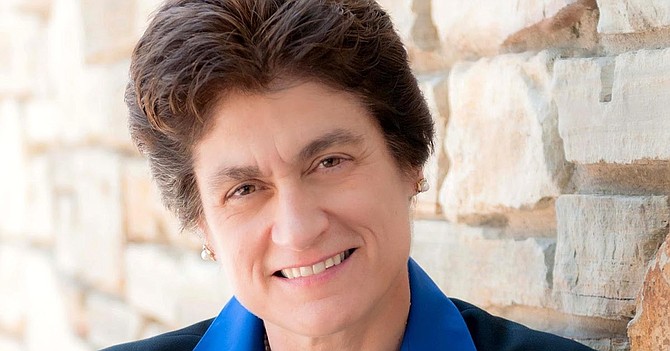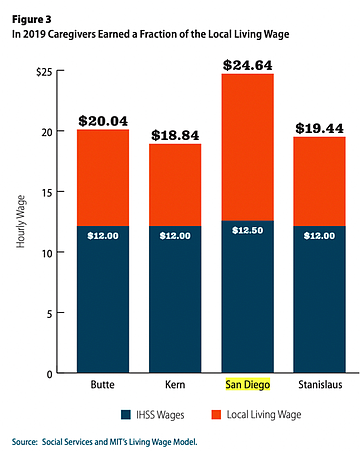Here's something you might be interested in.
Get Involved
 Facebook
Facebook
 X
X
 Instagram
Instagram
 TikTok
TikTok
 Youtube
Youtube

Should San Diegans who provide home care services to the elderly and others get at least the minimum wage? So posits an audit by California State Auditor Elaine Howle, which charges officials here with ignoring the law, resulting in a two-year underpayment of $19 million.
California's taxpayer-supported In-Home Supportive Services program, administered by counties, "serves more than 591,000 recipients," says state auditor Elaine M. Howle in a February 15 cover letter, "avoiding long-term care arrangements that would be much more costly to the State."
But auditors discovered that "more than 40,000 recipients on average did not receive in-home care each month, and that number is likely to grow," as "the gap between the number of recipients and the number of caregivers is widening."
Low pay is the primary culprit, per the findings.
According to the new study, which included the counties of San Diego, Butte, Kern, and Stanislaus, "caregivers throughout the State receive pay that is at or near minimum wage, and caregivers earn significantly less than a living wage in each county. In fact, many caregivers who work full time would qualify for public assistance."
"For example, in 2019, the living wage in Kern County was $18.84 per hour, while a caregiver earned $12 per hour, the state minimum wage. In San Diego County, the disparity was greater, with a living wage of $24.62 compared to hourly caregiver wages of $12.50."

Explains the report, "Living-wage calculations represent the wages necessary for a full-time worker to afford basic necessities without public assistance."
Two years earlier, the San Diego home-care workers faced even tougher times. '"Caregivers in the city of San Diego earned less than the local minimum wage for a part of 2016 and all of 2017," per the study.
"A City of San Diego ordinance set the minimum wage within the city at $10.50 and $11.50, respectively, in these years," the document says.
"However, after the city of San Diego established its local minimum wage, [California] Social Services offered guidance to San Diego's public authority that the ordinance did not apply to [In-Home Supportive Services], although the guidance did not explain why.
"As a result, [In-Home Supportive Services] caregivers in the city of San Diego received wages that were between 50 cents and $1 per hour less than the pay of other minimum-wage workers in that city.
"Had this local minimum wage applied to IHSS workers, they would collectively have been paid about $19 million more over the two-year period."
San Diego was not alone, the document notes.
"Between 2014 and 2019, localities in seven counties passed ordinances that raised local minimum wages by varying amounts; however, these localities declined to grant the increase to local IHSS caregivers.
"Although this may be permissible, it creates a situation in which [In-Home Supportive Services] work is not as competitive with positions that pay the local minimum wage."
The chronic pay deficits have spawned a yawning service gap, says the audit. "Recruiting a sufficient number of caregivers will be difficult because the job pays minimum or near-minimum wage, below a living wage in even the State's most affordable counties."
"The four counties we reviewed—Butte, Kern, San Diego, and Stanislaus—did not ensure that all recipients received services each month," according to the report.
"In fact, the average number of recipients who did not receive monthly services in these four counties generally increased over our review period."
"A growing number of recipients—tens of thousands each month—do not receive the services for which they qualify because the State and counties alike have failed to complete mandatory annual planning activities intended to ensure care for all recipients."
The audit holds out hope for San Diego, commending officials here for better planning than other California counties. "San Diego's plan has objectives aimed at building better health in its elderly population and includes performance measures that are specific to the [In-Home Supportive Services] program," the report says. " Such planning will be critical to ensure that all eligible recipients receive services each month."


Should San Diegans who provide home care services to the elderly and others get at least the minimum wage? So posits an audit by California State Auditor Elaine Howle, which charges officials here with ignoring the law, resulting in a two-year underpayment of $19 million.
California's taxpayer-supported In-Home Supportive Services program, administered by counties, "serves more than 591,000 recipients," says state auditor Elaine M. Howle in a February 15 cover letter, "avoiding long-term care arrangements that would be much more costly to the State."
But auditors discovered that "more than 40,000 recipients on average did not receive in-home care each month, and that number is likely to grow," as "the gap between the number of recipients and the number of caregivers is widening."
Low pay is the primary culprit, per the findings.
According to the new study, which included the counties of San Diego, Butte, Kern, and Stanislaus, "caregivers throughout the State receive pay that is at or near minimum wage, and caregivers earn significantly less than a living wage in each county. In fact, many caregivers who work full time would qualify for public assistance."
"For example, in 2019, the living wage in Kern County was $18.84 per hour, while a caregiver earned $12 per hour, the state minimum wage. In San Diego County, the disparity was greater, with a living wage of $24.62 compared to hourly caregiver wages of $12.50."

Explains the report, "Living-wage calculations represent the wages necessary for a full-time worker to afford basic necessities without public assistance."
Two years earlier, the San Diego home-care workers faced even tougher times. '"Caregivers in the city of San Diego earned less than the local minimum wage for a part of 2016 and all of 2017," per the study.
"A City of San Diego ordinance set the minimum wage within the city at $10.50 and $11.50, respectively, in these years," the document says.
"However, after the city of San Diego established its local minimum wage, [California] Social Services offered guidance to San Diego's public authority that the ordinance did not apply to [In-Home Supportive Services], although the guidance did not explain why.
"As a result, [In-Home Supportive Services] caregivers in the city of San Diego received wages that were between 50 cents and $1 per hour less than the pay of other minimum-wage workers in that city.
"Had this local minimum wage applied to IHSS workers, they would collectively have been paid about $19 million more over the two-year period."
San Diego was not alone, the document notes.
"Between 2014 and 2019, localities in seven counties passed ordinances that raised local minimum wages by varying amounts; however, these localities declined to grant the increase to local IHSS caregivers.
"Although this may be permissible, it creates a situation in which [In-Home Supportive Services] work is not as competitive with positions that pay the local minimum wage."
The chronic pay deficits have spawned a yawning service gap, says the audit. "Recruiting a sufficient number of caregivers will be difficult because the job pays minimum or near-minimum wage, below a living wage in even the State's most affordable counties."
"The four counties we reviewed—Butte, Kern, San Diego, and Stanislaus—did not ensure that all recipients received services each month," according to the report.
"In fact, the average number of recipients who did not receive monthly services in these four counties generally increased over our review period."
"A growing number of recipients—tens of thousands each month—do not receive the services for which they qualify because the State and counties alike have failed to complete mandatory annual planning activities intended to ensure care for all recipients."
The audit holds out hope for San Diego, commending officials here for better planning than other California counties. "San Diego's plan has objectives aimed at building better health in its elderly population and includes performance measures that are specific to the [In-Home Supportive Services] program," the report says. " Such planning will be critical to ensure that all eligible recipients receive services each month."
Comments